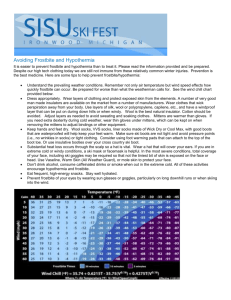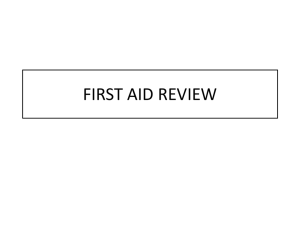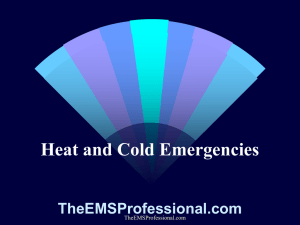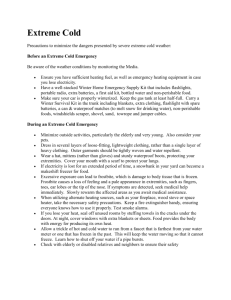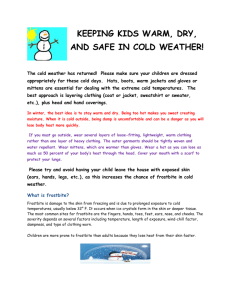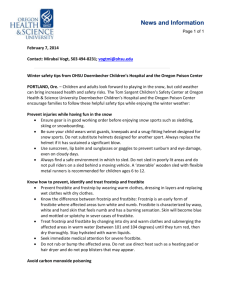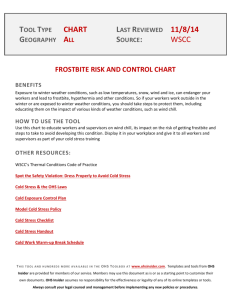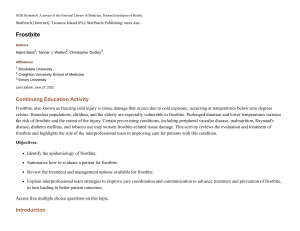5 MB 20th Apr 2015 Clinical Pearls of Wilderness Medicine
advertisement
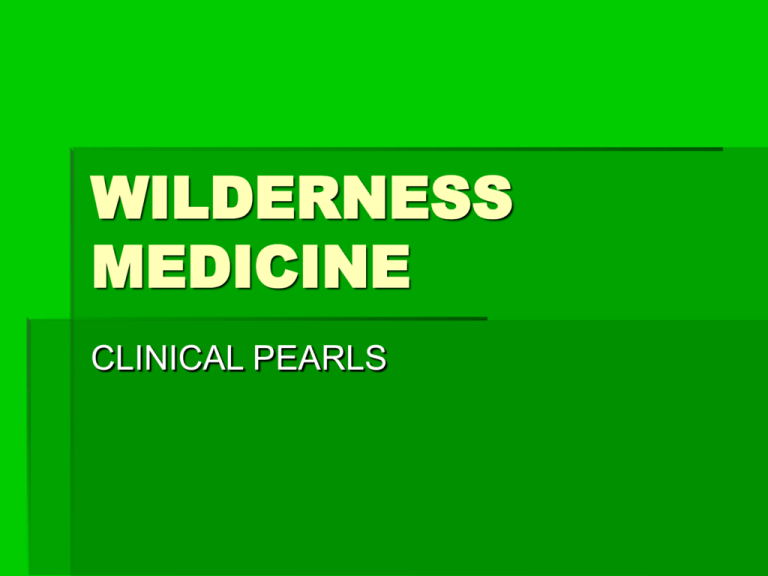
WILDERNESS MEDICINE CLINICAL PEARLS HIKING AVOID GETTING LOST Have a “fail safe” plan Look back at times when hiking out CRITTERS SNAKE BITE TREATMENT No tourniquets No new incisions No sucking out venom If possible, clean out wound, cover with gauze, splint limb and go to a hospital POLYVALENT ANTIVENOM 5 Vials for mild symptoms 10 Vials for moderate 15 Vials for severe Give 1/3 dose SQ near bite 1/3 dose IM 1/3 dose IV GENERAL POINTS Never run from predators OK to run from vegans WATER HEAT Boiling not necessary to make potable water Heating above 140 F for more than 5 minutes should be sufficient If no fuels for a fire, can pour alcohol on top of water and light it. New Big Auerbach box 61-6 p 1376 UV LIGHT All waterborne pathogens can be inactivated by UV light. If you can read newsprint through a bottle, 5 hours should be enough to kill off pathogens New Big Auerbach box 61-12 p 1395 HYPOTHERMIA POTOMAC RIVER CRASH JANUARY 13, 1982 CORE BODY TEMPERATURES 99.6 F Normal rectal temperature 93 Pre-hypothermia. Exhibits dysarthria, poor judgment 88 Extinguished shivering 82 V-fib. Unconscious 66 Flat EKG 57 Lowest adult hypothermia survival Adapted from Auerbach PS, Weiss EA, Donner H. Field Guide to Wilderness Medicine ACTIVE INTERNAL REWARMING Peritoneal lavage- 1-3 C/hr Thoracic lavage- 3-5 C/hr Cardiopulmonary bypass- 7-9 C/hr Therma-rescue- 2.5 C/hr. FROSTBITE Rewarm in warm water about 100-105 F Vasodilators – nifedipine Anticoagulants – heparin Thrombolytics – streptokinase, TPA Plasma volume expanders – low molecular weight dextran NSAIDs - Ibuprofen FROSTBITE REFERENCES Jenabzadeh K, Mohr W. Ahrenholz D. Frostbite: a single institution’s twenty year experience with intra-arterial thrombolytic therapy. J Burn Care Research. 2006;30: S103 Twomey JA, Peltier GL, Zera RT. An open-label study to evaluate the safety and efficacy of tissue plasminogen activator in treatment of severe frostbite. J Trauma. 2005; 59: 1350-1354. Cauchy E, Cheguillaume B, Chetaille E. A controlled trial of a prostacyclin and rtPA in the treatment of severe frostbite. N Engl J Med. 2011; 364: 189-190. Daum PS, Bowers WD Jr, Tejada J, Morehouse D, Hamlet MP. An evaluation of the ability of the peripheral vasodilator buflomedil to improve vascular patency after acute frostbite. Cryobiology. 1989;85-92. Penn I, Schwartz SI. Evaluation of low molecular weight dextran in the treatment of frostbite. J Trauma. 1964;4: 784-790. Rainsford KD. Ibuprofen: pharmacology, efficacy and safety. Inflammopharmacology. 2009;17:275-342. Murphy JV, Banwell PE, Roberts AH, McGrouther DA. Frostbite: pathogenesis and treatment. J Trauma. 2000;48: 171-178. HYPERTHERMIA IMPORTANT POINTS IN HYPERTHERMIA Heat exhaustion and heat stroke should not be thought of as separate entities but as a continuum Signs: malaise tachycardia increase LFTs sweating (even in heat stroke) altered mental status in heat stroke TREATMENT Rapid cooling Use warm water with a fan (not cold water) Ice bags in neck, axillae, groin, scalp Transport to an ER. Heat stroke is a life threatening emergency with a mortality of 30% to 80% Do not use aspirin or tylenol for the increased temperature Do not use beta blockers for the tachycardia ALTITUDE ILLNESS ACCLIMATION It takes 4 days to acclimate For an increase in RBC production it can take 4 to 8 weeks SIGNS AND SYMPTOMS Can occur when over 7,000 ft Headache Nausea Fatigue Dizzyness Insomnia Similar to a hangover Tachycardia Dyspnea Blood tinged sputum a late finding Can get cerebral edema and/or pulmonary edema Treatment Descent Hyperbaric chamber Acetazolamide- 125 to 250 mg BID po Dexamethasone- 4 mg QID po, IM or IV Viagra- does not help in treatment but can be used to prevent pulmonary edema Ginkgo and ibuprofen can help a little Wilderness and Environmental Medicine, 21, p 148 Table 2 (2010). LIGHTNING IF YOU CAN SEE A FLASH OR HEAR THUNDER YOU CAN BE HIT BY LIGHTNING HOW FAR AWAY After seeing a flash count in seconds to the thunder. Divide by 5. That gives you distance in miles. LIGHTNING SAFETY Do not lie down Stay on feet, crouch down, cover ears. OK to go under a thicket of trees but not a lone tree. Shun all metal Sit on and under anything insulating Tents are OK in there is no metal Lightning can travel through the ground
